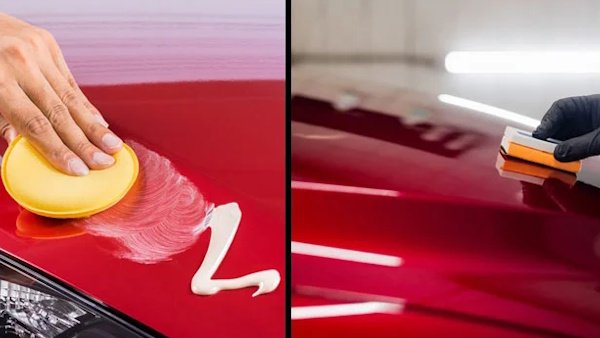Exploring the Scientific Research Behind Car Ceramic Coating and Its Safety Properties
The science of car ceramic coating offers a fascinating study in sophisticated auto protection. Made up mainly of silicon dioxide and polymers, these finishes form a durable bond with automobile paint. This communication boosts longevity against ecological risks while using hydrophobic advantages. The details of just how these layers job and their long-lasting advantages stay much less comprehended. Ceramic Coating Newark. Unboxing these details reveals why ceramic layers are coming to be a favored selection for automobile treatment
What Is Ceramic Coating?
Ceramic coating is a liquid polymer that chemically bonds to the surface of a lorry's paint. This advanced safety layer boosts resilience and provides premium resistance to ecological factors. Unlike typical wax or sealants, which provide short-term security, ceramic finishes produce a durable guard that can stand up to rough conditions such as UV rays, acidic pollutants, and extreme weather condition. When used correctly, the coating creates a hydrophobic surface area, creating water to grain and slide off, which helps in maintaining the lorry's tidiness. Furthermore, it supplies boosted gloss and deepness to the paint, making the vehicle show up even more polished and dynamic. The application procedure normally entails thorough surface prep work, including cleaning and polishing, to assure peak bonding. Because of this, ceramic coatings are coming to be increasingly preferred among car fanatics and those seeking to shield their investments, promising to preserve the car's visual appeal while decreasing the regularity of maintenance.
The Structure of Ceramic Coatings
The elaborate formulation of ceramic finishes primarily contains silicon dioxide (SiO2), which is stemmed from all-natural sources like quartz and sand. This crucial element supplies the structure for the coating's resilience and protective qualities. In enhancement to SiO2, ceramic layers often consist of various polymers and additives that enhance adhesion, adaptability, and resistance to ecological elements. These compounds work synergistically to develop a robust obstacle versus pollutants such as dirt, chemicals, and UV rays.Furthermore, some formulas integrate titanium dioxide (TiO2) or various other nanomaterials, which can enhance the coating's hydrophobic buildings, causing enhanced water repellency. The specific make-up can vary greatly among makers, impacting efficiency and longevity. Inevitably, the mix of these aspects finishes in a protective layer that not just boosts the aesthetic charm of cars but also offers to lengthen their life expectancy by securing the surface from prospective damage.
Just How Ceramic Coatings Job
Understanding how ceramic coverings work involves exploring their chemical structure, which adds to their protective top qualities. The application procedure is essential for achieving suitable results, while longevity and resilience elements identify the coating's effectiveness gradually. Together, these elements highlight the benefits and performance of ceramic finishes for vehicle protection.
Chemical Structure Explained
While many car proprietors seek lasting security for their vehicles, the chemical make-up of ceramic coatings plays a critical function in their performance. These coatings largely contain silicon dioxide (SiO2), which is stemmed from all-natural minerals. This substance creates a strong bond with the car's paint, producing a sturdy, safety layer. Additionally, several ceramic coatings consist of titanium dioxide (TiO2), boosting their hydrophobic residential properties and resistance to UV rays. The presence of polysiloxanes can further boost flexibility and resilience. Together, these components add to the coating's capacity to drive away water, dust, and impurities, while also offering a high-gloss surface. Understanding this chemical structure assists car owners appreciate the durable defense supplied by ceramic coverings.
Application Refine Summary
Applying ceramic finishes involves a thorough procedure that assures excellent bonding and defense for the automobile's surface area. Extensive cleaning and purification of the car's outside are executed to get rid of dust, grime, and previous waxes. This action confirms that the surface is without contaminations that could hinder attachment. Following this, the paint is commonly polished to enhance quality and eliminate any kind of blemishes. When prepared, the ceramic coating is used in tiny areas using an applicator pad, allowing for consistent coverage. The coating is then entrusted to cure, creating a solid chemical bond with the surface. Correct healing times and problems are crucial, as they validate the coating achieves its maximum effectiveness and protective qualities.
Longevity and Toughness Variables
Ceramic finishings are designed to provide long-lasting protection with their advanced chemical structure, which creates a durable barrier against environmental impurities. The longevity of these finishings is influenced by variables such as the thickness of the application, the high quality of the item, and the conditions under which the automobile is revealed. High-quality ceramic finishes can last numerous years, resisting scrapes, UV rays, and chemical spots. Proper maintenance, including normal washing and regular reapplication, can further boost long life. In addition, environmental elements like environment and exposure to pollutants can impact the lifespan of the coating. On the whole, when applied and preserved correctly, ceramic finishes offer outstanding durability, making them a prominent choice for car fanatics looking for to preserve their car's look.
Hydrophobic Qualities and Water Repellency
Hydrophobic properties are a characteristic of quality car ceramic finishes, significantly improving the lorry's surface performance. These coverings create a molecular bond with the car's paint, leading to a surface that wards off water successfully. When water comes right into call with a ceramic-coated surface, it beads up and rolls off, decreasing the amount of fluid that continues to be on the paint. This actions not only contributes to a visually pleasing look yet also decreases the home buildup of contaminants such as dust, gunk, and road salts.The improved water repellency brings about much easier cleaning and upkeep, as less initiative is called for to get rid of unwanted materials. In addition, the hydrophobic nature of ceramic coverings assists in preventing water areas, which can mar the finish of uncoated surface areas. On the whole, the consolidation of hydrophobic properties in ceramic finishings plays a vital role in keeping the automobile's beautiful appearance while simplifying upkeep.
Security Against Scratches and UV Damages
Car ceramic coverings use significant protection versus scratches and UV damage. The scrape resistance device creates a long lasting layer that takes in influences, while the UV securing advantages aid keep the lorry's paint stability with time. With each other, these functions contribute to a longer-lasting and visually enticing coating.
Damage Resistance Device
Making use of sophisticated technology, ceramic finishes provide a durable guard against scrapes and UV damage, boosting the long life and appearance of car surfaces. The scratch resistance mechanism of these coatings is credited to their one-of-a-kind molecular framework, which creates a durable bond with the lorry's paint. This bond produces a hard, safety layer that can absorb impacts and stand up to abrasions. Furthermore, the smooth surface of the coating decreases friction, making it challenging for pollutants to stick and cause scrapes. The chemical structure of ceramic coverings often consists of nanoparticles that strengthen the protective layer, further enhancing its resilience. Automobiles treated with ceramic finishings display noticeably improved scrape resistance contrasted to traditional wax or sealants, ensuring an immaculate surface over time.
UV Shielding Perks
The safety high qualities of ceramic finishings prolong beyond scrape resistance to consist of considerable UV securing benefits. These finishings produce a robust barrier that reflects hazardous ultraviolet rays, safeguarding the car's paint and underlying materials. Extended direct exposure to UV radiation can result in fading, oxidation, and wear and tear of the paint surface. By integrating ceramic finishings, lorry proprietors can efficiently mitigate these dangers, maintaining the aesthetic allure and honesty of their cars. In addition, the UV obstructing properties add to enhanced durability, minimizing the regularity of repainting and maintenance. Ultimately, the integration of ceramic finishes supplies a complete solution for protecting lorries from the harmful effects of sunlight direct exposure, ensuring a continual, vivid look gradually.
The Long life and Maintenance of Ceramic Coatings

Frequently Asked Inquiries
Can Porcelain Coating Be Applied to Any Kind Of Automobile?
Ceramic coating can be used to various sorts of automobiles, including cars and trucks, trucks, and motorcycles. Nonetheless, surface area prep work and compatibility with details products are essential for suitable bond and efficiency of the coating.
Just How Much Does Ceramic Coating Usually Price?
Ceramic coating typically costs between $500 and $2,000, depending upon factors such as vehicle dimension, coating quality, and expert application. The investment can provide durable defense and enhance the vehicle's look over time.

Is Specialist Application Essential for Best Results?
The necessity of continue reading this specialist application usually relies on wanted outcomes. Experts normally assure proper surface area prep work and application methods, resulting in perfect bonding and durability of the coating, which might be testing for unskilled individuals to accomplish.
Can Ceramic Coatings Be Removed or Fixed?
Ceramic coverings can be gotten rid of or fixed, though the process might call for details solvents or techniques - Ceramic Coating Newark. Appropriate removal is necessary to avoid damage to the underlying surface area, stressing the relevance of specialist assistance for suitable results
How Does Porcelain Coating Contrast to Traditional Wax?
The comparison in between ceramic coating and great site traditional wax exposes that ceramic finishes supply premium resilience, improved protection versus environmental contaminants, and longer-lasting shine, while wax requires much more constant application and gives less general resistance to damage.